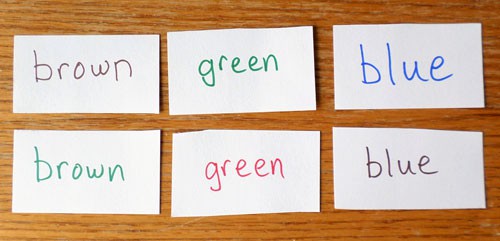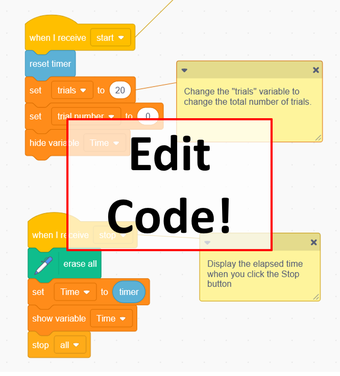What Conflicting Mental Tasks Reveal About Thinking: The Stroop Effect
Abstract
Can you pat your head with one hand while you rub your stomach with the other? This science project idea is kind of like doing that, but this project can actually give you some insight into how your mind works. The task is to name colors. It sounds simple enough, but see what happens when color words get in the way.Summary
Andrew Olson, Ph.D., Science Buddies
Sources
- Chudler, E. et al. (2006). Neuroscience for Kids: Stroop Effect Neuroscience for Kids, University of Washington, Seattle. Retrieved May 1, 2007.
- APA. (2007). Interference: The Stroop Effect. American Psychological Association.
- Stroop, J.R., 1935. "Studies of Interference in Serial Verbal Reactions," originally published in Journal of Experimental Psychology 18: 643-662, available online from Classics in the History of Psychology, York University, Toronto, Ontario. Retrieved May 1, 2007.
Objective
The goal of this project is to investigate the Stroop effect: when you try to name the color in which color words are printed, it takes longer when the color word differs from the ink color than when the color word is the same as the ink color.
Introduction
The experiment described in this science project is an attempt to unravel the workings of thought processes that involve attention, perception, reading, and naming. To give you an idea of how the experiment works, here is a task for you to try:
- In Figure 1, below, there are two rows of cards, where each card contains a word.
- The task is to name the color of the letters of each word (not to read the words).
- Try to the name each color as quickly as possible.

Figure 1. These are cards that help to demonstrate the Stroop effect. Note that the top row contains cards where the ink and color word match, whereas the bottom row contains cards where the ink and color word do not match.
Naming the colors was much harder for the second row, right? You may even have felt like you were fighting back an urge to read the color word out loud, rather than naming the color of the letters. Do you get the feeling that it takes longer, or that you had a longer reaction time, when naming the colors when the color word is different than the color? In this experiment, you will time responses from many volunteers in order to find out if this is the case.
This phenomenon was described in 1935 in a now-famous paper by John Ridley Stroop, and is known in experimental psychology as the Stroop effect. One explanation for the Stroop effect is called interference. From the earliest years of school, reading is a task that people practice every day. We become so good at it that we read words automatically. When we are asked to name the color of the word instead of reading the word, somehow the automatic reading of the word interferes with naming the color of the word. In this science project, you will investigate the Stroop effect with volunteers to determine exactly how much longer it takes people to name the color of the ink when the word it is written with is the same color word instead of a different color word.
If you want to explore how to expand further on this science project, you can check out the variations in the Make It Your Own section for some suggestions, and/or read on here for other ideas. The Stroop effect provides scientists with a measurable means to investigate how the brain works. By manipulating the stimuli used for an interference test in various ways, you can find out what types of thinking tasks interfere with other thinking tasks. For example, if you used nonsense strings of letters instead of color words, would there still be interference? Probably not. What if you scrambled the letters of the color words, or misspelled them, or bent them into circles? Each of these manipulations could help you to measure how easily people can read words, even when the words are not presented properly. If the interference effect persists, then you know that the manipulation did not affect the subjects' ability to read the words. You can also see if the Stroop effect occurs with non-color naming tasks: for example, naming shapes. Check out the Make It Your Own section for other variation ideas.
Terms and Concepts
- Attention
- Perception
- Reaction time
- The Stroop Effect
- Interference
Questions
- How does the concept of interference help to explain the Stroop effect?
- How is reaction time related to the Stroop effect?
- Can you think of some variations of the Stroop effect, such as using different or misspelled words? What results do you think you would get with volunteers testing such a variation?
Bibliography
Try this webpage for background information on the Stroop effect:
- Chudler, E. et al. (2006). Neuroscience for Kids: Stroop Effect. Neuroscience for Kids, University of Washington, Seattle. Retrieved May 1, 2007.
This is the original paper, from which the Stroop effect gets its name:
- Stroop, J.R., 1935. "Studies of Interference in Serial Verbal Reactions," originally published in Journal of Experimental Psychology 18: 643-662, available online from Classics in the History of Psychology, York University, Toronto, Ontario. Retrieved May 1, 2007.
Materials and Equipment
- Computer with a color printer
- Two sheets of cardstock (available at an office-supply store or stationer)
- Two envelopes
- Stopwatch
- Lab notebook
- Volunteers to take a simple color-naming test
- To see how many you need, check out the Science Buddies resource Sample Size: How Many Survey Participants Do I Need?.
Experimental Procedure
Working with Human Test Subjects
There are special considerations when designing an experiment involving human subjects. Fairs affiliated with Regeneron International Science and Engineering Fair (ISEF) often require an Informed Consent Form (permission sheet) for every participant who is questioned. Consult the rules and regulations of the science fair that you are entering, prior to performing experiments or surveys. Please refer to the Science Buddies documents Projects Involving Human Subjects and Scientific Review Committee for additional important requirements. If you are working with minors, you must get advance permission from the children's parents or guardians (and teachers if you are performing the test while they are in school) to make sure that it is all right for the children to participate in the science fair project. Here are suggested guidelines for obtaining permission for working with minors:
- Write a clear description of your science fair project, what you are studying, and what you hope to learn. Include how the child will be tested. Include a paragraph where you get a parent's or guardian's and/or teacher's signature.
- Print out as many copies as you need for each child you will be surveying.
- Pass out the permission sheet to the children or to the teachers of the children to give to the parents. You must have permission for all the children in order to be able to use them as test subjects.
Note: You can do this experiment with code instead of printed flash cards. You can edit the code yourself if you want to change something.
- Click the green flag to start the program.
- Click the "start timer" button when you are ready to start the timer.
- Click either the "matched" or "non-matched" button.
- Read the font colors of each word (not the words themselves) out loud.
- Click the "matched" or "non-matched" button again to generate a new list of words.
- Click the "stop timer" button when you are done with the last trial.
- Do your background research so that you are knowledgeable about the terms, concepts, and questions, in the Background section.
- Click the pdf file with four pages of color words
(requires Adobe Acrobat) that you can use for this project. Each page has the 20 sequences of five color words (red, blue, green, brown, purple) printed in pseudo-random order.
- Page one in the file has color words printed in matching color ink.
- Page two in the file has color words printed in different color ink (five examples of each different color).
- Note: Pages three and four have the color words printed in black ink. These can be used for a variation in the Make It Your Own section.
- Print the pages you need on card stock (for sturdiness), then cut them into horizontal strips.
- Keep the two sets in separate envelopes.
- Your volunteers will call out the ink colors as they read through the strips, one set at a time.
- For each volunteer, instruct them on what they are supposed to do in the test:
- You will be given a set of cards where each card contains a word printed in colored ink.
- The ink colors used are red, blue, green, brown, and purple.
- The task is to call out the ink color of each word as quickly as possible without making a mistake.
- You will be given two sets of cards total (one set at a time).
- Time how long it takes for the volunteer to name the colors in the set of cards with the non-matching words (timing how long it takes them to go through the entire set).
- You may want to make a data table in your lab notebook to collect your testing data.
- Time how long it takes for the volunteer to name the colors in the set of cards with the matching words.
- Repeat steps 4–5 with each volunteer, but for half of the volunteers, reverse the order and use the set with the matching words first.
- Calculate the average time to name the colors for each set.
- Calculate the time difference for each volunteer (i.e., non-matching word time minus the matching word time). Then calculate the average difference for the group of volunteers.
- Make bar graphs to illustrate your results.
- Analyze your results. How noticeable is the time reaction delay due to the Stroop effect?
Ask an Expert
Global Connections
The United Nations Sustainable Development Goals (UNSDGs) are a blueprint to achieve a better and more sustainable future for all.
Variations
- What if the words printed in colored ink are not color words? Does interference still occur?
- What if you use nonsense words, i.e. random strings of characters like 'xgwrf'? Does interference still occur?
- Does interference still occur if the test words are turned upside down or rotated 90°? Design an experiment to find out.
- What if you use single letters? Does it matter if the letters match the first letter of the color name?
- Another way to investigate the finding would be to look for the effect with youngsters who know their colors but don't yet know how to read. Would you expect to find the Stroop effect in this age group?
- For an alternative experiment that investigates whether the Stroop effect occurs with shapes, see the Science Buddies project Shaping Your Thoughts?
- A slightly different experiment would be to measure the speed for reading a list of color words printed in matching color vs. color words printed in black. What would you expect to find? Note: pages 3 and 4 of the pdf file of color words are printed in black ink. Page 3 has the words in the same order as page 1, and page 4 has the words in the same order as page 2.
- Advanced. Another idea would be to test non-native English speakers. Perhaps reading English is not automatic for this group and the interference would not occur. As a control, you could also have them try the test with the words printed in their native language.
- Advanced. Does practice make any difference with the Stroop effect? In other words, can people improve their times by practicing naming colors? Design an experiment to find out.
- Advanced. Another idea for a follow-on experiment would be to see if distortions of the words (e.g., printing the letters on a circular, instead of horizontal, baseline) would decrease or eliminate the interference. See the Science Buddies project Warped Words and the Stroop Effect for details.
Careers
If you like this project, you might enjoy exploring these related careers:












